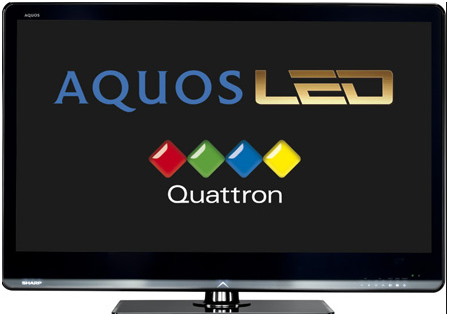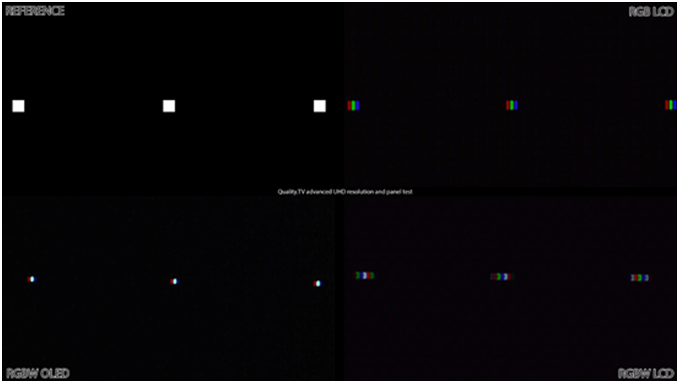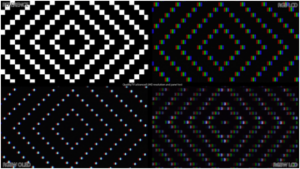It’s true, UHD TVs with a reduced subpixel count really do exist. And it seems that even the well-known brand LG has no qualms about launching Ultra HD televisions with cut-down definition. Could this ultimately do a disservice to the triumphant introduction of UHD resolution? I think so – and I would like to offer some clarification.

How pixels work
A single pixel in a television is intended not only to glow at the brightness level indicated in the signal, but also to produce the color defined by the signal. Since time immemorial, computer monitors and televisions have achieved this using the principle of additive color mixing, whereby the desired colors are produced by mixing the primary colors red, green, and blue in corresponding ratios. Lighting up all three primary colors at the same time produces a white pixel. Green and red together make yellow – and so on.
Individual subpixels are so small that they are barely visible, unless viewed at high magnification.
Incidentally, the pixels in a photo file on a computer work in exactly the same way: each pixel is assigned a value for red, green, and blue and is therefore ideally suited to displays with RGB subpixels.
Additional subpixels
Approaches to delivering extra subpixels have been around for a long time. Sharp, in particular, has repeatedly raised eyebrows with its “Quattron” brand. The aim here was to use an additional yellow subpixel to make yellow and golden hues appear more realistic and also to boost resolution through further subpixel division and specialized control technology. Even if it benefits could be proven in certain situations, there were still two problems:
- The hue of the yellow subpixel was outside of the standard color space and delivered hard-to-predict colors that, although they sometimes looked great, were not what the movie producers envisaged.
- It is only possible to achieve a slight increase in resolution, as the position of the subpixels does not match the pixel grid of the source material. What’s more, it is not possible to influence the color of the additional pixels.
 Sharp Quattron: Four subpixels give the impression of offering advantages.
Sharp Quattron: Four subpixels give the impression of offering advantages.
In principle, it can be argued that there is nothing wrong with additional subpixels if they are used in a controlled manner to improve display properties. This is currently the case in RGBW OLED TVs, which would not be as luminous without their additional white subpixels.
Fewer subpixels
Things are different when the supposedly ‘additional’ subpixel is inserted in order to omit others, as is currently the case in some budget TVs from China. Much to everyone’s surprise, however, the practice has even caught on with brand-name manufacturer LG, which markets some sets of this kind as normal UHD TVs – without including a corresponding disclaimer. The ensuing debate in the USA has already triggered an official response, in which an LG spokesman played down concerns.
The view expressed there is clearly that resolution is not compromised, despite the missing subpixels. Ultimately, it is possible to find standards that result in either no or barely any measurable difference. No mention is made here of other, more critical test standards (including some from the same IDM standardization committee).
 If you look at individual pixels, they appear to be stretched horizontally on the RGBW LCD; here, up to 5 subpixels are used despite the low subpixel count.
If you look at individual pixels, they appear to be stretched horizontally on the RGBW LCD; here, up to 5 subpixels are used despite the low subpixel count.
Here in Germany, the LG 43UF6909 is one example of a TV with a reduced subpixel count. It remains to be seen which other devices are affected – LG fails to mention the limitation and describes the device as a UHD TV with 3840 x 2160 pixels. At its current asking price of €850 on Amazon, you can’t even call it a particularly good deal, which might justify the compromise. In any case, if you haven’t spotted it already, the disappointment strikes when you connect a PC and try to get a sharp picture of the desktop, text, and menus. None of the picture settings offer any relief: many intricate picture details simply disappear, and you can’t even bring them back with fine tuning.
An example calculation
Let’s look at the specifics: if every other pixel consists of only one white subpixel instead of RGB subpixels, this gives the following ratios for UHD:
3840 pixels x 3 subpixels = 11,520 subpixels for a normal RGB structure.
(1920 pixels x 3 subpixels) + (1920 pixels x 1 subpixel) = 7680 subpixels for an RGBW structure.
7,680/11,520=2/3.
Or, in other words: a third of the subpixels are missing.
Now you could say that, out of 3840 pixels in the horizontal, fewer than 2561 pixels remain in certain circumstances, such as coloured details, and that the display’s resolution is therefore less than 3K.
It is not that simple, however, because a lot depends in such a situation on how exactly the individual pixels are addressed. Moreover, the vertical resolution of 2160 lines is also theoretically unaffected.
The true behavior of an RGBW display can therefore only be elucidated through tests.
Extended resolution tests
For practical reasons, many of the resolution tests from renowned standardization bodies such as the ITU, EBU, or SMPTE (as well as those from THX, the CEA, etc.) were initially developed so that a display’s resolution could be measured based on the contrast ratio of fine details. For simplicity’s sake – and with RGB subpixel structures in mind – tests and measurements were then performed primarily using horizontal and vertical brightness structures.
It is no wonder, therefore, that RGBW panels with a reduced subpixel count were able to pass some resolution tests. Of course, these were then dubbed “UHD TVs” with typical marketing exaggeration. There is therefore an urgent need to revise the corresponding picture and testing standards.
Thanks to new resolution and panel tests such as the “Quality.TV advanced UHD resolution and panel test”, it is possible to mercilessly expose the problems caused by a reduced pixel count. (Declaration of interest – the author developed the test – Man. Ed.)
Quality.TV’s “Advanced UHD resolution and panel test” is suitable for testing the resolution of UHD TVs. Provided you have a suitable camera with a powerful macro lens, this test allows you to analyze display parameters at the subpixel level. Even without such a camera, you’ll be able to identify resolution losses as they appear.
This has already been demonstrated in a video from Quality.TV. In the video, each comparison shows the reference structure of the test pattern in the top left. The top right shows a UHD TV with an RGB subpixel structure (Samsung 55JU6450).
On the bottom left we see the image on an RGBW OLED TV (LG 55EG9609), and on the bottom right the image on an RGBW LCD TV with a reduced pixel count (LG 43UF6909).

This pixel structure is reproduced correctly by all televisions, although the contrast is already suffering on the RGBW LCD and there is some brightening at the corners.

The TV with an RGBW LCD panel can still keep up to a reasonable extent when tested with the green pyramid structure. However, the lines are already starting to look washed out, and if you follow the green subpixels, you can see that they do not lie exactly in a straight line, unlike in the other image sections.
A 1-pixel checked pattern is already too much for the RGBW panel with the reduced subpixel count. The structure is completely lost.

Green lines with a width of 1 pixel show only a low level of contrast and are barely recognizable.

A similar problem with 2×2-pixel checked patterns: the RGBW panel can no longer depict the boundaries sharply.

A big surprise: the grid on a white background is two pixels thick. This corresponds to half UHD resolution or, to be precise, Full HD. Although this should not present a problem for a UHD display, the horizontal boundaries are already blurry. Even a Full HD panel can do a better job of this!
The video from Quality.TV shows even more examples of limitations in pixel structure:
In conclusion, don’t let yourself be ripped off! For proper UHD, every pixel in the source material must correspond to a pixel on the display that it can address directly and whose color it can influence. This currently only works in displays with at least three subpixels. For accurate UHD, you therefore need at least 24.88 million subpixels (3840*2160*3) on the screen. The manufacturers should inform their customers of the number of subpixels on a display – at least on request – or include this information in the technical data in order to deliver greater transparency. UHD TVs that struggle to display some details even in HD resolution, leaving many UHD structures completely blurred, can justifiably be called “pseudo UHD”. Given their technical shortcomings, that is still putting it kindly. Florian Friedrich
Florian Friedrich is CEO of the German test laboratory, AVTOP, and co-founder of Quality.TV.
Since 1999, Friedrich has been always hunting for the perfect picture. His test laboratory, AVTOP, has supported many major publishers with thousands of reviews and is also distributing gear for a better home theatre experience.
Quality.TV is a partnership between Friedrich and Joe Kane, providing test and demonstration materials in order to identify picture quality issues and help to improve them.

